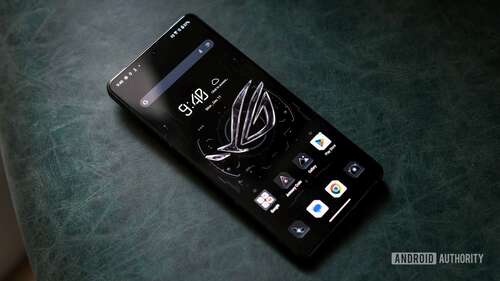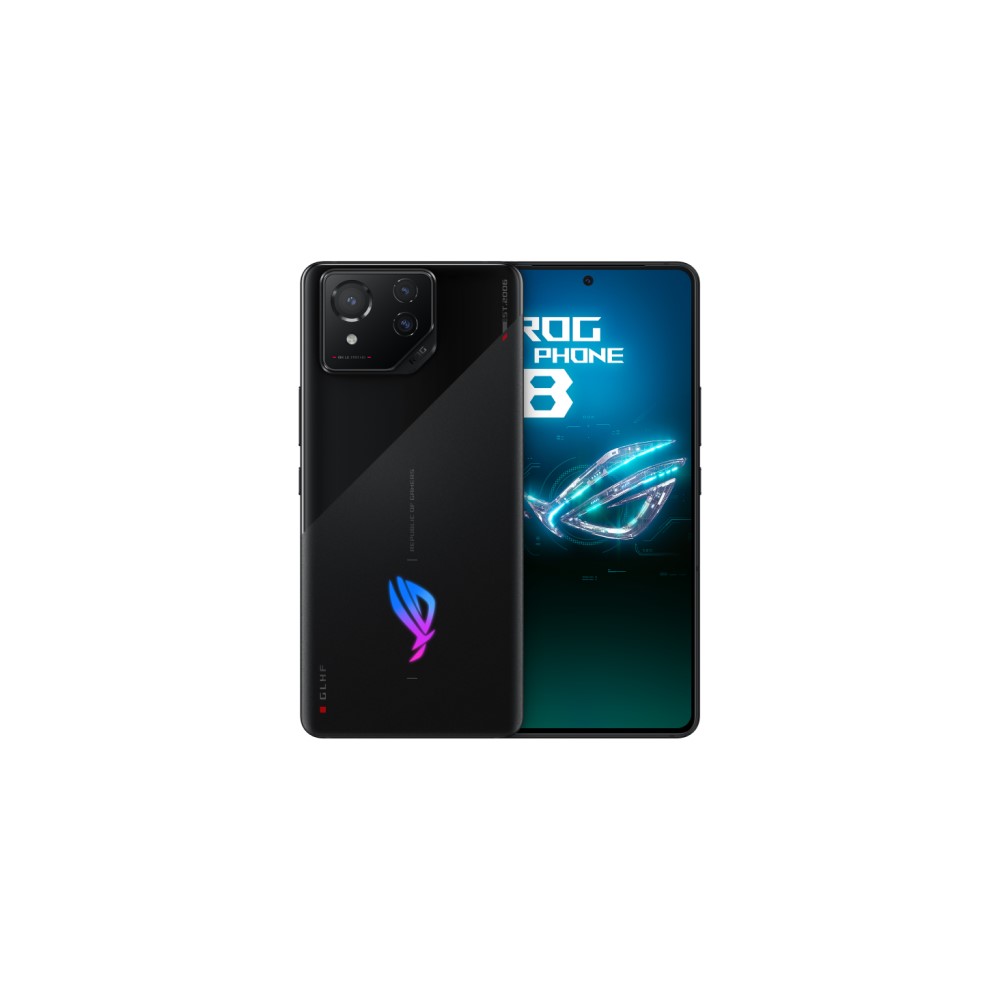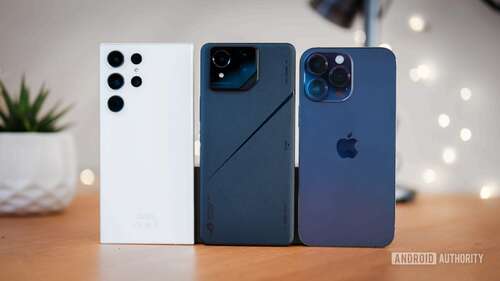ASUS ROG Phone 8
The ROG Phone 8 is the most well-rounded iteration of ASUS’ gaming formula yet. A slimmer design, improved cameras, and wireless charging creature comforts make this a premium gaming phone that doesn’t compromise on being, well, a phone.
ASUS ROG Phone 8 review: At a glance
- What is it? The ROG Phone 8 is ASUS’ gaming smartphone for 2024, packing top-tier performance and advanced gaming features to make the most of the best mobile titles. The ROG Phone 8 series, comprising the regular and Pro models, is the successor to 2023’s ASUS ROG Phone 7 range.
- What is the price? The ASUS ROG Phone 8 starts at $1,099.99 for the base 12GB/256GB model, with a pre-order price of $999.99. The ROG Phone 8 Pro starts at $1,199 for 16GB/512GB and the top-of-the-line model, complete with bundled cooler, costs $1,499. In the UK, the ROG Phone 8 starts at £949.99 and the Pro costs £1,099.
- Where can you buy it? ASUS has not confirmed when the phone will launch in the US, but it should arrive by the summer of 2024. UK and wider European pre-orders opened on January 9, 2024, and the phones will ship in China, Hong Kong, Europe, Taiwan, and the UK in January.
- How did we test it? I tested the ASUS ROG Phone 8 Pro for ten days. The review unit was supplied by ASUS.
- Is it worth it? The ASUS ROG Phone 8 bridges the gap between gaming and mainstream phones more than any ROG Phone before it, but remains focused on the former. Household phone brands will still better serve those looking for a superb all-rounder to dabble in the occasional game, but if you play for many hours a day and want to leverage ASUS’ suite of accessories and apps, the ROG Phone 8 and 8 Pro are the best entries in the series yet.
Should you buy the ASUS ROG Phone 8?

Robert Triggs / Android Authority
A quick glance lets you know that there are some big changes in store for the ROG Phone 8. The gaudy gamer aesthetic of years gone by is replaced by a design that feels more reminiscent of the Zenfone 10. I’d hesitate to call it a mainstream look; there’s still LED backlighting and ASUS’ capacitive AirTriggers for gaming. But if, like me, you’ve been hesitant to pull past ROGs out of your pocket in public, the ROG Phone 8’s thinner body, slimmer bezel, and more understated design are less conspicuous. Thankfully, the 3.5mm headphone jack and dual USB-C ports remain series staples.
Speaking of design, there are some key differences between the ROG Phone 8 and Pro Edition. The latter comes with customizable “AniMe Vision” backlighting instead of the light-up ROG logo. There are also options for 16GB/512GB and 24GB/1TB storage configurations with the Pro, and a bundled AeroActive Cooler X ($99.99 separately) with the top-end model. $100 more for lighting is a bit steep for me. Thankfully, both feature an IP68 rating and Qi 1.3 wireless charging for the first time, which makes the daily experience much more in line with a Galaxy or Pixel. The ASUS ROG Phone 8 really is an all-rounder this time.
The redesign hints at another significant change. There’s a new camera setup, boasting a 50MP IMX890 sensor with gimbal stabilization (again lifted from the Zenfone), a new free-form lens on the ultrawide camera, and a new 32MP telephoto camera with 3x optical zoom. That’s a more flexible setup than before that, again, aims to nudge the phone into the frame as more than just a gaming phone.
Broadly speaking, color saturation, white balance, and exposure are the camera’s main strengths, and nearly all my shots looked pretty solid for social without the need for editing. The new 3x telephoto camera also ensures a higher level of quality when moving from ultrawide to cropped-in, and the phone is very versatile in that regard. ASUS’ latest camera package is undoubtedly an improvement. That said, the ultrawide can suffer from lens flare and, despite AI upscaling, zooming to 5x and beyond yields hit-and-miss results. Furthermore, the phone’s HDR implementation produces a far too heavy bloom effect, selfies are quite noisy even in outdoor lighting, bokeh edge detection isn’t great, and there’s a heavy dose of oversharpening on all three rear lenses.
Video is arguably the more compelling experience, thanks to ASUS’ brilliant gimbal stabilization. I didn’t find any use for the maximum Hypersteady 1080p-limited option (but you’ll benefit if you lead a less sedentary lifestyle), so I enjoyed stable 4K video footage using the default Adaptive setting. Overall, the ASUS ROG Phone 8 has a more than functional camera setup that’s better than you’ll find on other gaming phones. However, image quality is just below par for the phone’s asking price more broadly. If photography is a priority and you have $1,000 to spend, Apple, Samsung, and the more affordable Google should be your go-to camera phone choices.
ASUS’s redesign makes this a phone for much more than gaming.
Returning to the AI hype train, the ROG Phone 8 boasts AI audio noise cancelation for both incoming and outgoing audio, 10x Hyper Clarity Zoom, photo segmentation, Semantic Search in the gallery app (à la Google Photos), and X Sense 2.0 pattern recognition for select games. It’ll also support offline AI wallpaper generation in a future update. They’re all neat additions that are hard to fault, but none provide a truly game-changing experience. Still, at a premium price, we’re increasingly expecting little extras like this, and ASUS delivers.
Now let’s get into the real reason to buy a ROG Phone: performance. As you would expect from a gaming phone, the latest Qualcomm Snapdragon 8 Gen 3 processor zips through your daily workloads like a knife through warm butter. That said, ASUS has gone to great lengths to optimize the phone this year. The default mode is even more conservative than past models, with CPU benchmark results below the ROG Phone 7 series in some instances. It certainly didn’t benchmark as highly as expected based on Qualcomm’s 8 Gen 3 reference phone when I initially put it through our test suite.
When I flipped on X-Mode it rose nearer the top of our leaderboard, albeit with a not-quite-flawless performance in our stress tests, and it didn’t keep up with the REDMAGIC 9 Pro. Stress test results also weren’t as consistent as last year’s model and even fell below the ROG Phone 7.
ASUS notes higher results in its literature, but I could not reach the same performance levels with our stealth benchmark APKs. However, ASUS blocked benchmark Play Store downloads during the review period. Having spoken to ASUS and resolving the issue, I’m now seeing results far closer to expectations for Qualcomm’s top chip. Sadly, we didn’t get time to complete these before publishing, but I’ll be updating the review accordingly with the final numbers in the following days.
The ASUS ROG Phone 8 remains fast to charge, thanks to 65W charging based on the universal USB PD PPS protocol. I clocked it at 51 minutes to full and just 18 minutes to half charge. The 5,500mAh battery is slightly smaller than last year’s 6,000mAh cell but takes about the same time to charge.
Thankfully, the cell takes you through a full day and more. Our battery tests suggest five hours of 4K video recording and picture capture, 10 hours of web browsing or Zoom calls, 23 hours of 4K video playback, or at least three hours of the most intensive gaming. That’s comparable to last year’s model, scoring about 50 minutes better on our web and Zoom call tests but just over an hour worse at 4K video capture and picture shooting time.
Turning to software, four years of security updates and at least two major OS updates remain a below-par commitment at this price. Four years of secure use isn’t a bad pledge; it’ll protect the phone for a solid portion of its potential lifespan, but you will miss out on newer Android feature editions after just two years. Given ASUS’ lightweight take on Android 14, it’s hard not to feel shortchanged while rivals push on with seven-year OS update promises. Equally, the ROG Phone has historically been neglected for updates, receiving flagship OS upgrades up to as much as six months after their wider rollout. That could change with the ROG Phone 8, but I wouldn’t bet on it.
ASUS’ Armoury Crate houses a familiar assortment of performance configurations, game profiles, key and trigger mappings, video and screenshot records, game recording, and countless other features to help you make the most of your gaming time. It’s a familiar setup if you’ve used previous models, with only minor tweaks to support new ROG Phone 8 features like the Pro’s AniMe Vision. Gaming enthusiasts continue to be well catered to by ASUS’s software suite.
In summary, the ROG Phone 8 and 8 Pro are the most well-rounded iterations of ASUS’ gaming formula yet. A slimmer design, improved cameras, and wireless charging creature comforts make this a premium gaming phone that doesn’t compromise on being, well, a phone. But this design has left less room for gaming-specific hardware, such as the cooling port, and the phone doesn’t appear to be quite the top performer that gamers have come to expect from the series. Overall, these changes are for the better, and gamers will surely embrace the slight diversion in direction. However, despite these changes, it’ll struggle to muscle in meaningfully on the mainstream flagship competitors, who still prioritize a more robust photography experience and many more years of support that appeal to a broader audience.

ASUS ROG Phone 8
Zenfone-like design • IP68 rated, finally • Fast charging and excellent battery life
New look, same gaming greatness.
With a Snapdragon 8 Gen 3 processor, AI-centric gaming features, a sleeker aesthetic, and additions like IP68 water resistance and wireless charging, the ASUS ROG Phone 8 is a mighty leap for the gaming phone king.
What are the best ASUS ROG Phone 8 alternatives?

Robert Triggs / Android Authority
Straddling the line between mainstream and gaming phones means plenty of competition for the ASUS ROG Phone 8 and 8 Pro. With prices starting at a rather steep $1,100, the alternatives boast high-end performance, solid camera setups, and bleeding-edge bespoke features. Whether you should go for the ROG or shop elsewhere, it all comes down to what you value the most.
- Samsung Galaxy S24 Ultra ($1609 at Samsung): The best all-around phone on the market right now, the new Samsung Galaxy S24 Ultra is a great alternative to the ROG Phone 8 and 8 Pro, even if you’re a gamer. Solid performance from the 8 Gen 3, a flexible quad-camera setup, bleeding-edge AI features, and a long-term update commitment make this a hard phone to beat. ASUS’s gaming accessories and software give gamers something extra, but Galaxy is the better all-rounder.
- Apple iPhone 15 Pro Max ($1199 at Amazon): When you’re spending top dollar, the iPhone 15 Pro Max will be on virtually any list, but recent gaming upgrades and a high-end A17 Pro chip makes Apple’s behemoth especially worthy of consideration here. Again, ASUS’ gamer-centric features should sway those who plan to play every day, but Apple’s ecosystem, cameras, and performance are all-around impressive when shopping at a premium price point.
- REDMAGIC 9 Pro ($649 at Manufacturer site): When it comes to the very best gaming performance, the REDMAGIC 9 Pro currently tops our benchmark suite, besting the ROG Phone 8 in both peak performance and our stress tests. This alternative doesn’t compete well with broader features, such as camera, IP rating, and aesthetics. Still, it should be on every mobile gamer’s radar, especially as it costs just a fraction of what ASUS charges for an 8 Gen 3 chip.
ASUS ROG Phone 8 specs
| ASUS ROG Phone 8 | |
|---|---|
|
Display |
6.78-inch Dynamic AMOLED |
|
Processor |
Snapdragon 8 Gen 3 |
|
RAM |
12GB/16GB/24GB LPDDR5X |
|
Storage |
256GB/512GB/1TB UFS4.0 |
|
Power |
5,500mAh battery |
|
Cameras |
Rear:
– 50MP wide main sensor (f/1.9, 1/1,56-inch sensor, PDAF, 6-axis hybrid gimbal stabilization) – 13MP ultrawide (f/2.2) – 32MP 3x telephoto (f/2.4, 0.7-micron pixel size) Front: |
|
Software |
ROG UI / Zen UI |
|
IP rating |
IP68 certified |
|
Biometrics |
In-display fingerprint scanner |
|
Dimensions |
163.8 x 76.8 x 8.9 mm |
|
Weight |
225g |
|
Colors |
Black |
ASUS ROG Phone 8 review: FAQ
Yes, the ASUS ROG Phone 8 supports wireless charging via the Qi 1.3 standard for up to 15W of power.
The ASUS ROG Phone 8 has an IP68 rating for water and dust resistance.
No, there is no SD card slot on the ROG Phone 8. However, the phone is available in up to 1TB storage configurations for those with a large storage requirement.
The ASUS ROG Phone 8 is powered by a Snapdragon 8 Gen 3 processor that excels at mobile gaming. While benchmarks suggest this isn’t the fastest gaming phone around, ASUS’ cooling accessories ensure robust performance for long play sessions.

